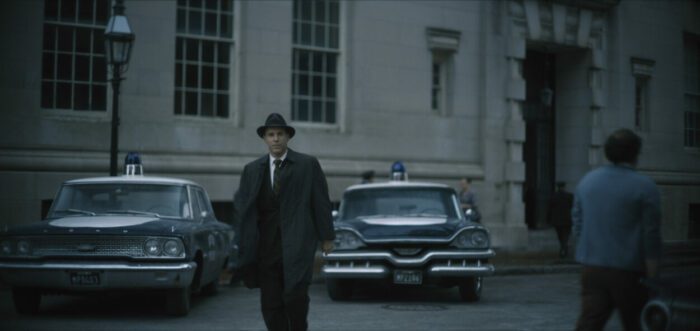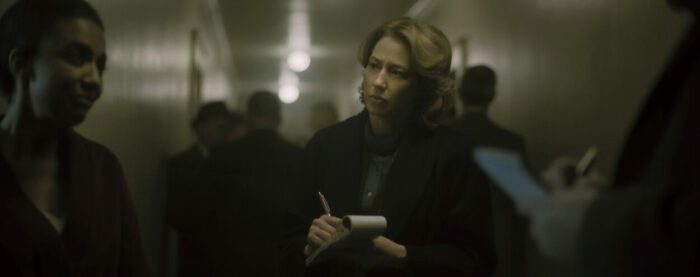At a crucial moment in Boston Strangler during her ongoing inquest, journalist Loretta McLaughlin, played by headliner Kiera Knightley, poses a pointed question to Alessandro Nivola’s Detective Conley. She asks, “How do you just stop caring after all this?” Representing years of failed leads and public discontent in the police department, Nivola’s inspector thinks for a second and answers, “When you realize you can give up your life for it and no one would give a shit.” For once, the sharply intelligent Loretta doesn’t have a pushback counterpoint in reply.
In that exchange, you see the grim and borderline haunting big picture that besets the virtuous chess players of Boston Strangler. Conley, Loretta, and her partner Jean Cole, played by Carrie Coon, represent two virtually thankless professions that are forced to move with the shifting tides of tragedy. A cop and a reporter will witness or immerse themselves in heinous crimes while required to leap to the next assignment that occurs in their direction. Recognition and, more importantly, closure for those professions are fleeting, if not impossible.

Don’t believe that impossibility? Just look at the majority of well known true crime stories or even narrow it down to serial killers. Mildly savvy students of history and trivia will recognize names like Jeffrey Dahmer, Charles Manson, Ted Bundy, John Wayne Gacy, and more. Can they name the stalwart cops who arrested any of them or the brilliant journalists who cracked any of their cases? Probably not, and they are supposed to be the heroes of it all. Shouldn’t they be remembered and mentioned in the same breath? Welcome to giving up one’s life for no one to give a shit.
Through one of the more positive uses of its lionization powers, pop culture can help. Movies, television shows, and songs create new household names. Look at how the name of Eliot Ness has become synonymous with Al Capone thanks to The Untouchables. With similar respectful and valiant intentions, Matt Ruskin’s new Hulu film Boston Strangler seeks to place the important heroes alongside, and ultimately higher than, the more famous villains they chased. The movie trudges forward with that weight of unshakable day-to-day responsibility.

Boston Strangler chronicles the investigation of the titular serial killer story from the 1960s. Over the course of a year-and-a-half, thirteen women were targeted, sexually assaulted, and killed without forced entry. Each was found with the calling card of a carefully tied garrote of pantyhose or silk stalkings around their necks. The community panic that gripped the Athens of America grew exponentially with the surmised realization that these murders were quite possibly performed by the same individual.
Those evidence-supported hypotheses of commonalities among these tragic “sisters in death” were first reported by Loretta McLaughlin and Jean Cole in the Record American newspaper. Shedding the workplace gender politics that pigeon-holed them to the Lifestyle desk of kitchen appliance reviews and fashion events, Loretta had to beg for this chance to prove herself. The savviness of the more experienced and better connected Jean became a tremendous boost to Loretta’s passion as the two would scoop the bigger rags in town and give the killer their now-famous name.

Moreover, McLaughlin and Cole’s thoroughness outmatched the Boston Police Department, represented most in the film by Nivola, and put them on notice for their failure to make an arrest or protect their city. Letters pouring into the Record American office from captivated readers—many of which were fellow women—paint a picture of the public anxiety. As the number of victims grows, so do the stories of women talking through women.
Despite its headline-inducing title, Boston Strangler stays predominantly on our two dauntless reporters weathering ire from law enforcement, garnering support from their editor Jack Maclaine (Academy Award Chris Cooper), and, in Loretta’s case, dealing with the extended time commitments that take her away from her discontented husband James (steady TV actor Morgan Spector) and three young children. Carrie Coon was employed to be the rock, but this remains Keira Knightley’s showcase. Much like playing a different kind of whistleblower in Official Secrets from 2019, would you believe the ageless Brit is actually a few years older than her historical subject? Her maturity continues to match her allure.

By focusing on the valuable journalism, writer-director Matt Ruskin (Crown Heights) shields most of the crimes and actions of the suspected serial killer. The first murder presented in Boston Stranger is observed by a man hearing a struggle from the other side of an apartment wall. The separation of rooms may suppress the brutal activity happening, but the sounds are more than enough. Grim audience imagination takes over, which is always a solid narrative effective.
Experienced crime film fans will point at the works of David Fincher for comparison watching Boston Strangler. The stylistic emulation is wise and tempered. Matching the muting of R-rated violence, the film’s more fearful than visceral darkness is enriched further by the work of director of photography Ben Kutchins (The White Lotus). The emerging cinematographer clutches a consistent lighting profile that stays very dreary, repressed, and even morose with its heavy shadows and hidden figures. Composer Paul Leonard-Morgan (Limitless) maintains that tone through the next set of senses.

As a feature film, Boston Strangler finds itself buried in the massive snowbank of true crime content available. Eager viewers have a buffet of binge-able rabbit holes, available in long and short forms, on dozens of channels and platforms at home. Held up against that docu-drama marketplace, a traditional two-hour fictionalized yarn playing in theaters feels nearly trite and tame by comparison, even if it dabbles with and challenges a theory or two about who really perpetrated these murders.
Boston Strangler certainly carries a “name brand,” so to speak. There is shock and sizzle to be had with this legendary and highly disputed case. Only so much, though, can come from the milder newspaper side of the story. Boston Strangler, for better or worse, needed more of its ominous titular villain. Those looking for a more forensic treatment of this historical hullabaloo will not find that satisfaction here. Yet, there’s more than enough respectful polish and attempts at prestige in Boston Strangler to stand out slightly above the pile of repetitive television entries.



